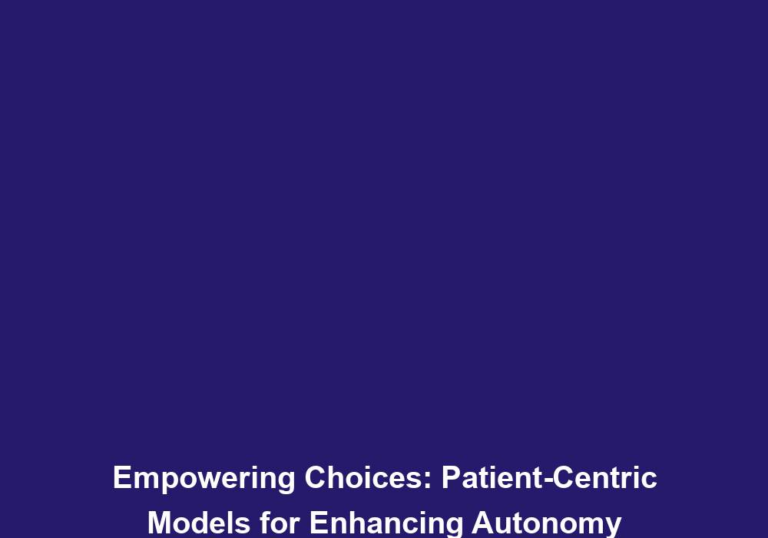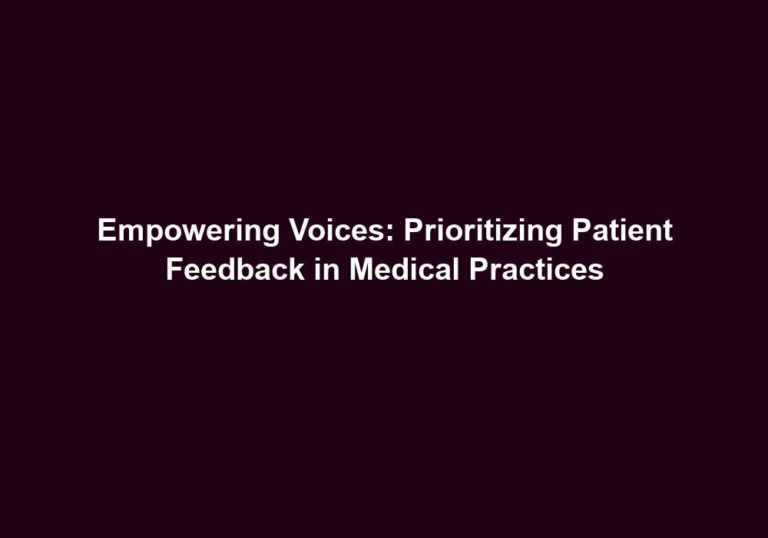Putting Patients First: The Rise of Patient-Centric Care in Modern Medicine
In the ever-evolving landscape of modern medicine, there has been a significant shift towards patient-centric care. This approach emphasizes the importance of putting patients at the center of their own healthcare journey, focusing on their unique needs, preferences, and goals. With this shift, healthcare providers are recognizing the value of effective communication, shared decision-making, and personalized treatment plans. In this article, we will explore the concept of patient-centric care, its benefits, and the strategies that can be implemented to ensure its successful implementation.
The Concept of Patient-Centric Care
Patient-centric care is a philosophy that prioritizes the individual patient and places them at the forefront of their own healthcare experience. It recognizes that each patient is unique and has their own set of needs, preferences, and values. By adopting a patient-centric approach, healthcare providers aim to deliver care that is tailored to the specific requirements and circumstances of each patient.
Patient-centric care goes beyond just diagnosing and treating medical conditions. It involves understanding the patient as a whole person and considering their physical, emotional, and social well-being. Healthcare providers take the time to listen to patients, understand their concerns, and involve them in decision-making processes. This collaborative approach ensures that patients feel heard, respected, and empowered in their healthcare journey.
Benefits of Patient-Centric Care
-
Improved Patient Outcomes: By actively involving patients in their own healthcare decisions, patient-centric care leads to better health outcomes. When patients feel empowered and engaged in their treatment plans, they are more likely to adhere to prescribed medications, therapies, and lifestyle changes. This active participation in their own care can result in better disease management, reduced complications, and improved overall health.
-
Enhanced Patient Satisfaction: Patient-centric care fosters a sense of partnership between healthcare providers and patients. When patients feel listened to, understood, and respected, their satisfaction with the healthcare experience increases. This can lead to increased trust in the provider, improved patient loyalty, and positive word-of-mouth referrals. Patients who have a positive healthcare experience are more likely to actively seek medical care when needed, leading to improved overall health outcomes.
-
Increased Efficiency: By understanding and addressing the unique needs of individual patients, healthcare providers can streamline the delivery of care. Personalized treatment plans that align with patients’ preferences and goals can help to minimize unnecessary interventions, reduce hospital readmissions, and optimize resource utilization. This not only improves the patient experience but also contributes to cost savings and resource allocation within the healthcare system.
-
Empowered Healthcare Providers: Patient-centric care also benefits healthcare providers. By actively involving patients in their care, providers gain valuable insights into patients’ perspectives, allowing them to make more informed clinical decisions. This collaborative approach enhances the overall quality of care delivered. Healthcare providers who practice patient-centric care report higher levels of professional satisfaction and engagement, as they are able to build stronger relationships with their patients and witness the positive impact of their interventions.
Strategies to Implement Patient-Centric Care
To effectively implement patient-centric care, healthcare organizations and providers can adopt various strategies that foster patient engagement and satisfaction. These strategies include:
1. Effective Communication
Clear and open communication is at the heart of patient-centric care. Healthcare providers should actively listen to patients, address their concerns, and provide them with comprehensible information about their condition, treatment options, and potential outcomes. This communication should take into account patients’ individual preferences and health literacy levels, ensuring that information is relayed in a manner that is easily understood.
Effective communication involves not only providing information but also actively engaging patients in discussions about their healthcare. Providers should encourage patients to ask questions, express their concerns, and actively participate in decision-making processes. By promoting two-way communication, healthcare providers can build trust, establish a therapeutic alliance, and ensure that patients have a clear understanding of their healthcare journey.
2. Shared Decision-Making
Shared decision-making involves healthcare providers and patients collaborating to make informed decisions about treatment plans. By considering patients’ values, preferences, and goals, providers can offer a range of options and help patients understand the potential risks and benefits associated with each choice. This approach empowers patients to actively participate in the decision-making process, ensuring that their unique needs and values are considered.
Shared decision-making requires healthcare providers to engage in effective communication and provide patients with all the necessary information to make informed choices. Providers should explain the available treatment options, discuss the potential outcomes, and address any concerns or uncertainties that patients may have. This collaborative approach not only respects patients’ autonomy but also improves treatment adherence and patient satisfaction.
3. Patient Education and Empowerment
Educating patients about their conditions, treatment options, and self-care practices is essential for patient-centric care. Healthcare providers should provide patients with reliable and accessible information to help them make informed decisions about their health. Empowering patients with knowledge and resources equips them to actively manage their own health, leading to improved self-care and better treatment outcomes.
Patient education should be tailored to individual patients’ needs and preferences. Providers can use various educational methods such as verbal explanations, written materials, videos, or online resources to deliver information in a format that patients find most helpful. By ensuring that patients have a clear understanding of their conditions, treatment plans, and self-care practices, healthcare providers empower patients to take an active role in their healthcare journey.
4. Care Coordination and Continuity
Patient-centric care also involves ensuring seamless coordination and continuity of care across different healthcare settings and providers. This can be achieved through effective care coordination strategies, such as electronic health records, shared care plans, and regular communication between healthcare professionals. By promoting collaboration and information sharing, patient-centric care enhances the overall continuity and quality of care delivered to patients.
Care coordination requires healthcare providers to work together as a team, ensuring that patients’ healthcare needs are addressed comprehensively. Providers should communicate and share information effectively, ensuring that all members of the healthcare team are aware of the patient’s medical history, treatment plans, and progress. This interdisciplinary approach improves the efficiency of care delivery, reduces the risk of medical errors, and enhances patient satisfaction.
5. Feedback and Continuous Improvement
Engaging patients in obtaining feedback about their healthcare experiences is crucial for improving patient-centric care. Healthcare organizations should actively seek patient input through surveys, focus groups, and patient advisory councils. This feedback can provide valuable insights into areas for improvement, allowing organizations to make necessary changes to enhance the patient experience and better meet their needs.
Feedback from patients helps healthcare organizations identify strengths and weaknesses in their delivery of patient-centric care. By actively listening to patient feedback, healthcare providers can identify areas where improvements can be made, whether it’s in communication, access to care, or the physical environment. Continuous improvement based on patient feedback ensures that patient-centric care remains an ongoing priority for healthcare organizations.
In conclusion, patient-centric care is gaining prominence in modern medicine, placing patients at the center of their healthcare journey. By prioritizing effective communication, shared decision-making, patient education, care coordination, and feedback, healthcare providers can ensure that patients receive personalized, empowering, and high-quality care. Embracing patient-centric care not only leads to improved patient outcomes and satisfaction but also empowers healthcare providers to deliver care that truly meets the unique needs of each patient.







